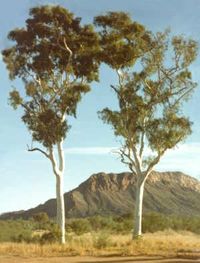Catastrophic consequences of small nuclear war
Global hell of limited nuclear conflict
John Johnson in San Francisco
December 13, 2006
EVEN a small nuclear war could have catastrophic environmental and societal consequences, extending the death toll far beyond the number of people killed directly by bombs, says the first comprehensive climatic analysis of such a conflict.
Scientists say a few dozen Hiroshima-sized nuclear weapons exchanged between India and Pakistan, for example, could produce a pall of smoke that would encircle the Earth, causing temperatures to fall worldwide and disrupting food production for millions of people.
Owen Toon, an atmospheric researcher at the University of Colorado, told a meeting of the American Geophysical Union on Monday that although a small nuclear exchange might not trigger a "nuclear winter" that would wipe out all life, it could cause as much death as was once predicted for a nuclear war between the US and the Soviet Union.
"These results are quite surprising," Dr Toon said. Regional nuclear conflicts "can endanger entire populations" the way it was once thought only worldwide conflict could.
Dr Toon and his co-author Richard Turco, a professor of atmospheric sciences at the University of California, Los Angeles, were part of the team of scientists that developed the concept of nuclear winter in the 1980s.
The analysis was presented in two papers that dealt with the climatic, atmospheric and social consequences of a regional exchange. The studies were published in the online journal Atmospheric Chemistry and Physics Discussions.
Since the 1980s, when the US and Soviet Union began reducing their nuclear stockpiles, the number of weapons around the world has declined by a factor of three, Dr Toon said. There are now about 10,000 such weapons, and that is expected to drop to 4000 by 2012.
But the number of potential nuclear-armed nations has risen dramatically. Dr Toon said 40 countries had the fissile material to build nuclear weapons. Many that could build them were unstable or in dispute with their neighbours.
In conducting their research, the scientists looked at other global cataclysms, such as the 1815 eruption of Tambora volcano in Indonesia. It triggered the "year without a summer", which led to lethal frosts and crop losses in the north-eastern US and crop failures and famine in Europe.
The authors said even a limited nuclear conflict would be much worse, killing as many as 17 million people in China alone.
The biggest atmospheric impact from such an exchange would be the accumulation of smoke and soot in the atmosphere, said Professor Georgiy Stenchikov, of Rutgers University. He estimated 5 million tonnes of soot could be thrown into the air by the explosion of about 100 15-kiloton weapons. This would rise into the stratosphere and stay there for up to 10 years, causing temperatures to fall several degrees.
Los Angeles Times
To read the original article in the Sydney Morning Herald, click on:
SMH
John Johnson in San Francisco
December 13, 2006
EVEN a small nuclear war could have catastrophic environmental and societal consequences, extending the death toll far beyond the number of people killed directly by bombs, says the first comprehensive climatic analysis of such a conflict.
Scientists say a few dozen Hiroshima-sized nuclear weapons exchanged between India and Pakistan, for example, could produce a pall of smoke that would encircle the Earth, causing temperatures to fall worldwide and disrupting food production for millions of people.
Owen Toon, an atmospheric researcher at the University of Colorado, told a meeting of the American Geophysical Union on Monday that although a small nuclear exchange might not trigger a "nuclear winter" that would wipe out all life, it could cause as much death as was once predicted for a nuclear war between the US and the Soviet Union.
"These results are quite surprising," Dr Toon said. Regional nuclear conflicts "can endanger entire populations" the way it was once thought only worldwide conflict could.
Dr Toon and his co-author Richard Turco, a professor of atmospheric sciences at the University of California, Los Angeles, were part of the team of scientists that developed the concept of nuclear winter in the 1980s.
The analysis was presented in two papers that dealt with the climatic, atmospheric and social consequences of a regional exchange. The studies were published in the online journal Atmospheric Chemistry and Physics Discussions.
Since the 1980s, when the US and Soviet Union began reducing their nuclear stockpiles, the number of weapons around the world has declined by a factor of three, Dr Toon said. There are now about 10,000 such weapons, and that is expected to drop to 4000 by 2012.
But the number of potential nuclear-armed nations has risen dramatically. Dr Toon said 40 countries had the fissile material to build nuclear weapons. Many that could build them were unstable or in dispute with their neighbours.
In conducting their research, the scientists looked at other global cataclysms, such as the 1815 eruption of Tambora volcano in Indonesia. It triggered the "year without a summer", which led to lethal frosts and crop losses in the north-eastern US and crop failures and famine in Europe.
The authors said even a limited nuclear conflict would be much worse, killing as many as 17 million people in China alone.
The biggest atmospheric impact from such an exchange would be the accumulation of smoke and soot in the atmosphere, said Professor Georgiy Stenchikov, of Rutgers University. He estimated 5 million tonnes of soot could be thrown into the air by the explosion of about 100 15-kiloton weapons. This would rise into the stratosphere and stay there for up to 10 years, causing temperatures to fall several degrees.
Los Angeles Times
To read the original article in the Sydney Morning Herald, click on:
SMH


<< Home